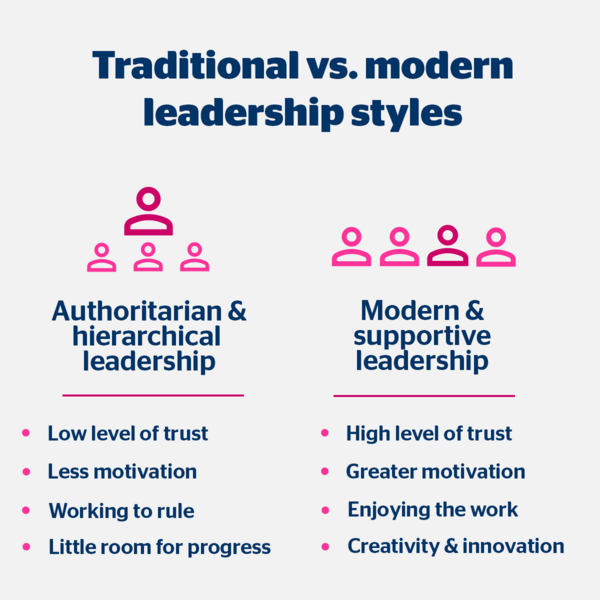New leadership: An overview of the best modern leadership styles
|

reading time: ca. 6 minutes
- Traditional leadership styles don't meet the challenges of the modern working world any longer. Instead, modern forms of leadership that focus on cooperation, empowerment, and the distribution of responsibility are moving into the spotlight.
- The most important modern leadership styles include, for example, empowering leadership, shared leadership, and inspirational leadership.
- The approach of these leadership styles is to empower and motivate employees so that they independently pursue goals.
- To create the right environment for a new leadership style, you need a lot of trust and open communication – and the right mindset.
The way we work has changed dramatically over the last decades. Traditional leadership methods are no longer up-to-date – instead, new leadership styles and leader competencies are gaining relevance. In the age of New Work, mobile working, and digitalisation, new leadership focuses on empowerment and personal responsibility instead of “work to rule”.
Top-down orders, strict hierarchies, and control? That is history. The leaders of the future are more “coach” than “boss”. They inspire, advise, and support instead of command.
Especially younger people of Generation Y and Generation Z greatly value self-determined work, responsibility, and flexibility.
It is no surprise that the traditional way of leadership has outlived its usefulness. To make New Work possible at all, new leadership styles such as shared leadership, inspirational leadership, or empowering leadership are necessary.
But it is not only today's labour market conditions that make new leadership necessary. Modern leadership sustainably increases employee motivation.
And this is becoming increasingly important: the State of the Global Workplace Report 2024 not only shows that engagement in the workplace is stagnating worldwide. The study also states that Europe has the lowest proportion of motivated employees in a global comparison, namely just 13 per cent. According to Gallup, a lack of motivation costs the global economy around 8.9 trillion US dollars a year.
What modern leadership styles are there?
There are plenty of modern leadership styles that meet the requirements of the digital working world. Many styles overlap in some respects and differ in others.
Which leadership style fits best depends on multiple factors, for example on company type, company size, and corporate culture. The personality and competencies of the manager and their employees are also important.
These are the top 3 most important modern leadership styles:
- Empowering leadership
- Shared leadership
- Inspirational leadership

Empowering leadership
Empowering leadership focuses on the empowerment of employees. Above all, this improves the creativity and innovation potential of the teams. People who work independently are also demonstrably more motivated and productive.
Employees are given the freedom to work autonomously and make their own decisions. This applies, for example, to their allocation of tasks, time management, or the way in which certain goals are achieved. They are involved in major corporate decisions and play an active role in shaping processes.
Leaders act as coaches and strengthen the self-management skills of their teams. Instead of giving orders and distributing tasks, teams are empowered to guide themselves.
Shared leadership
In shared leadership, the entire leadership responsibilities and decision-making power are distributed widely throughout an organisation. This leadership style goes one step further than empowering leadership.
All team members share responsibility and motivate each other.
Instead of commanding or controlling, managers encourage their employees to take responsibility. They act as supporters, the classic “boss” does not exist in shared leadership.
Inspirational leadership
Inspirational leadership focuses on the relationship with employees.
Inspirational leaders encourage and motivate their team, lead by example, and stand up for their values. Empathy, positivity, passion, and authenticity are important qualities.
Inspirational managers do not try to achieve their goals alone. Instead, they work to help others achieve their best. They encourage their employees even in difficult times. Through enthusiasm and commitment, they convince them to work towards a certain vision or a common goal.

Already in 2018, a Harvard study described the positive effects of empowering leadership in companies. Data from over 30,000 employees from 30 countries was analysed.
The results clearly demonstrated the positive influence on creativity, social behaviour, happiness, and, above all, the performance and commitment of employees.
Since then, a lot has happened in terms of New Work and leadership. More and more companies are integrating modern leadership approaches and benefiting from them:
- Personal responsibility and self-determined work are promoted.
- There is less workload for managers. They have more time for other tasks, for example process optimisation or organisation.
- Motivation, productivity, and creativity of employees are improved.
- At the same time, employee happiness, loyalty to the company, and identification with corporate values increase.
- Teams achieve better results and deliver higher output.
- Collaborative success and shared leadership create strong team spirit.
- The company becomes attractive to young professionals in the labour market. That makes it easier to recruit new employees.
Old vs. new leadership styles
The traditional leadership styles include above all the authoritarian style. Here, typically top-level management makes the decisions and employees merely carry out instructions.
Steep hierarchies create distance so that there is little trust between managers and teams.
This leads to low employee commitment and a “work to rule” attitude.
Today, we know that too much control doesn't leave much room for creativity, innovation, and growth.
The more direction, the less initiative among employees.
In contrast, motivation and enthusiasm emerge from trust, empowerment, and participation. Personal responsibility and visions can encourage top performance.

What's next?
The expectations of managers have changed dramatically. There is a major shift of thinking about power distribution, trust, and decision-making in companies. Interpersonal skills are becoming more important than technical know-how.
Leadership is constantly changing. And this is quite necessary because the working world and its frameworks are changing as well. What is innovative today will be standard tomorrow and outdated the day after.
That is why flexibility and a high degree of innovation are important. Managers must constantly rethink and adapt their style to changing needs and new challenges.
It is not only Generation Z that places high demands on companies. In a few years, the first members of the new Generation Alpha will enter the labour market.
Independence and flexibility are likely to expand even more. Modern managers will become “enablers”. Instead of setting guidelines or making decisions, they will ensure that all resources and frameworks are in place.
The fact is: Future leadership is characterised by more and more cooperation, communication, and equality.



